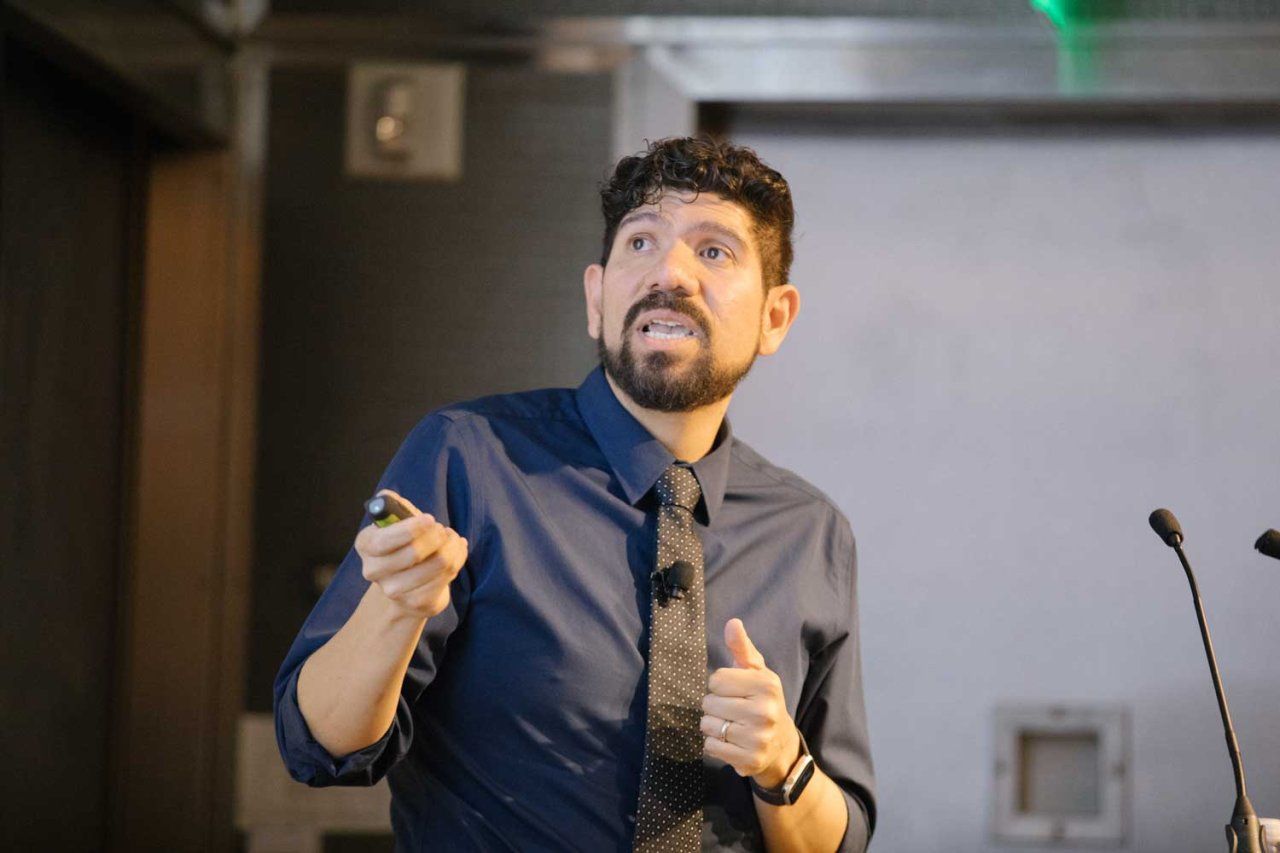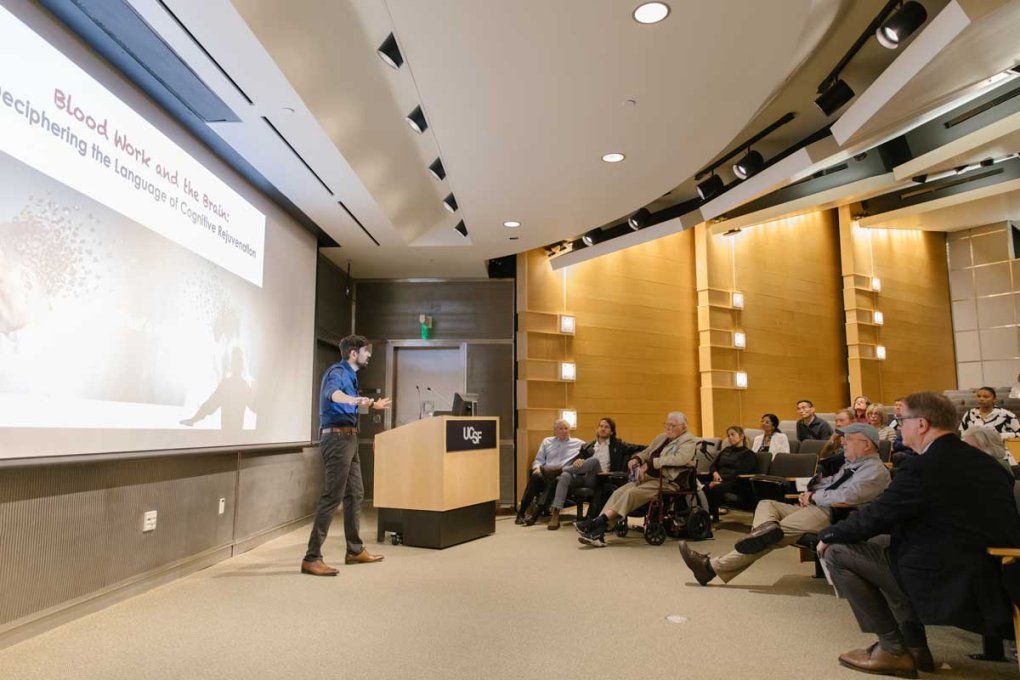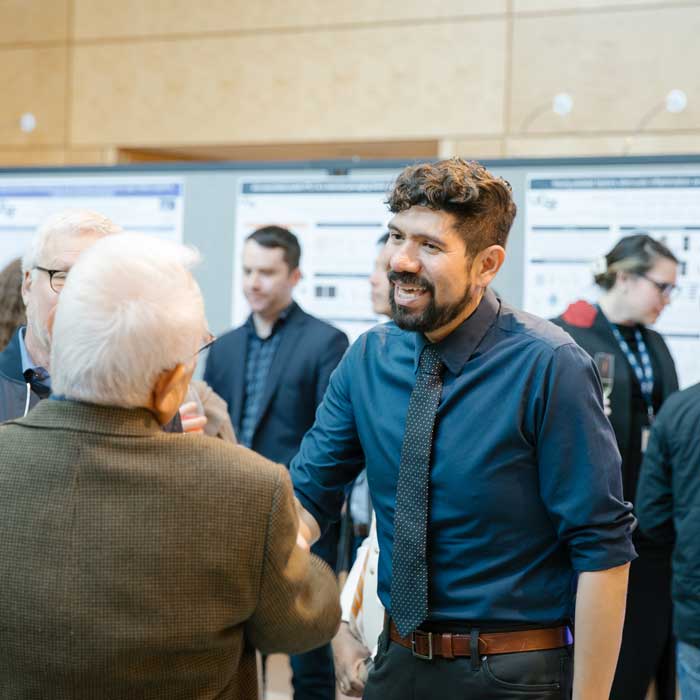Does Exercise Rejuvenate Blood, Improve Cognitive Function?
Saul Villeda Delivers 2023 Byers Award Lecture on Reversing Aging’s Effects on the Brain
We’ve all been there. You walk out of the office after a long workday, look out over a sea of cars, and wonder, “Now where the heck did I park?”
When you’re young, remembering comes easy. “Oh, yeah,” you quickly deduce, “over there, by that coffee cart, where I bought a cappuccino and a blueberry muffin.” But as you get older, your recall gets slower and less certain. More and more, you find yourself wandering aimlessly while clicking the unlock button on your key fob in hopes of hearing your car’s familiar beep.
“That’s your brain on aging,” neuroscientist Saul Villeda, PhD, said during an honorary lecture about his work as the 2023 Byers Award recipient. He delivered the talk, titled “Blood Work and the Brain: Deciphering the Language of Cognitive Rejuvenation,” on April 24.

Villeda is the Endowed Professor of Biomedical Sciences in the Department of Anatomy and associate director of the UCSF Bakar Aging Research Institute. His lab studies the biological mechanisms that drive cognitive impairments with age and how this seemingly inevitable decline might be reversed.
“The overarching question that I’m really passionate about is, can we preserve our identity by countering aging?” Villeda said. As he laid out during the talk, the answer looks encouragingly like “yes.”
The annual Byers Award, established in 1995 with a philanthropic gift from Brook and Shawn Byers and their family, recognizes outstanding research by a faculty member in the middle of their career. “The award has grown to be a hallmark of scientific excellence here at UCSF,” Sam Hawgood, MBBS, UCSF chancellor and the Arthur and Toni Rembe Rock Distinguished Professor, said during his opening remarks. “Each year, it encourages the scientists and students in this room to think bolder, work harder, and never stop trying to change the world.”

“Dr. Saul Villeda is committed to advancing scientific knowledge for the benefit of people everywhere,” Hawgood continued. “We’re lucky to have him represent the many brilliant minds at UCSF and be such a great advocate for discovery science.”
The renowned Byers Award lecture series is hosted by the Sandler Program for Breakthrough Biomedical Research (PBBR), which funds innovative ideas that are unlikely to receive traditional financial backing. The program was permanently endowed in 2021 in honor of its founders, the late Herbert and Marion Sandler, with a $25 million gift from Sir Michael Moritz KBE and Harriet Heyman through their Crankstart foundation. Since its beginning in 1997, PBBR support has generated 3,700 peer-reviewed publications, 115 patents, and more than $1.68 billion in federal and other grants.
Aging in the Blood
Villeda’s path to science began in East Los Angeles, where he grew up after his parents emigrated from Guatemala. “I’m a California baby through and through,” he told his audience. Although Spanish is his first language, he taught himself English by watching Sesame Street and Mister Rogers’ Neighborhood, which he credits for “introducing me to the idea of imagination and discovery.”
“I realized that … I could dream as big as I wanted to,” he said. His dream became education. In college at UCLA, he read a seminal paper in developmental biology that “blew my mind” and sparked his passion for basic science. He went on to earn his PhD from Stanford University, where, in the lab of neuroscientist Tony Wyss-Coray, PhD, Villeda considered the aging brain from a new perspective.
“You can’t just think about the brain,” he recalled reasoning. “You have to think about the entire body.” And what connects every tissue in the body? “It’s blood.”
The overarching question that I’m really passionate about is, can we preserve our identity by countering aging?
So, working with mice, Villeda and his colleagues explored how the makeup of an animal’s blood affects its cognition and changes as the animal ages. “What we found is that old blood is pretty bad,” he said. “There are pro-aging factors that come up as you get older, and they are 100% driving aging mechanisms within your brain.”
That got the team wondering if the opposite also was true. As Villeda put it, “Is it just that old blood is communicating aging, or is it possible that young blood can actually communicate youth and rejuvenation?” It was a crazy idea, he admitted. But preliminary evidence suggested it was also a promising one, and it became the launch pad for Villeda’s research program at UCSF.
“There are certain places where you can be crazy,” he said. “UCSF is one of them.” Villeda joined UCSF in 2012 as a Sandler Fellow, which allowed him to establish his own lab at the Eli and Edythe Broad Center of Regenerative Medicine and Stem Cell Research.
An Exercise Molecule
Villeda has since built a robust body of research revealing blood-borne molecules and interactions that impact brain function – and that might one day be tapped for anti-aging therapies. In his talk, he highlighted one such molecule: an enzyme called GPLD1.
GPLD1 seems to confer the benefits of exercise on the aging brain. When a mouse or human exercises, Villeda’s lab found, its liver churns out more of this enzyme than when it’s sedentary. Let loose in the blood, the enzymes act like tiny scissors; they snip specific protein tags on cells throughout the body, thereby triggering important signaling cascades.
Some of the cells that GPLD1 targets reside in the blood-brain barrier. This implies that the enzyme may play a crucial role in keeping this barrier healthy, Villeda said.
Sure enough, his team showed that GPLD1 can prevent or repair damage to the blood-brain barrier and improve cognitive function in aging mice. In one experiment, old mice had to solve a water maze. At first, these mice made more mistakes than young ones. But after the researchers expressed GPLD1 in the livers of the elderly animals, their maze-solving abilities improved. “They started acting like a younger animal,” Villeda explained. (Expressing a defective copy of GPLD1 didn’t yield the same rejuvenating effect.)
“We’re starting to decipher the language of this cognitive rejuvenation,” he said. And there are other languages of youth or old age yet to be decoded – ones that speak through the immune system or the vascular system, for instance. “Because we’re all aging in slightly different ways,” Villeda concluded, “understanding the different languages will allow us to be able to target different aspects of aging.”

2023 Byers Award
The Byers Award recognizes outstanding research by a faculty member in the middle of their career.
Saul Villeda’s honorary lecture is titled “Blood Work and the Brain: Deciphering the Language of Cognitive Rejuvenation.”